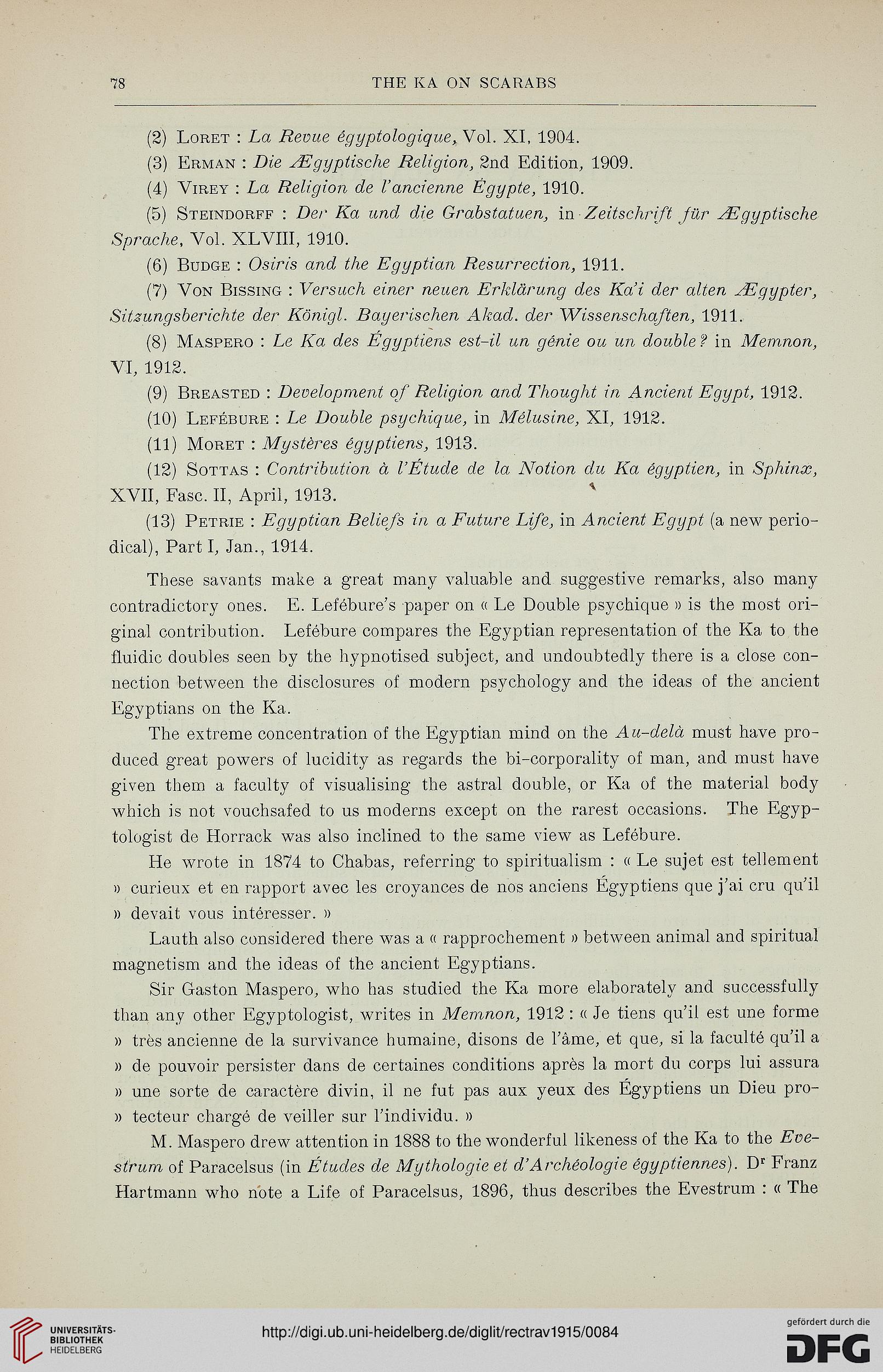78
THE KA ON SCARARS
(2) Loret : La Revue égyptologique, Vol. XI, 1904.
(3) Erman : Die JEgyptische Religion, 2nd Edition, 1909.
(4) Virey : La Religion de l'ancienne Egypte, 1910.
(5) Steindorff : Der Ka und die Grabstatuen, in ■ Zeitschrift jiïr JEgyptische
Sprache, Vol. XLVIII, 1910.
(6) Budge : Osiris and the Egyptian Résurrection, 1911.
(7) Von Bissing : Versuch einer neuen Erklàrung des Kai der alten JEgypter,
Sitzungsberichte der Kônigl. Bayerischen Akad. der Wissenschaften, 1911.
(8) Maspero : Le Ka des Égyptiens est-il un génie ou un double ? in Memnon,
VI, 1912.
(9) Breasted : Development of Religion and Thought in Ancient Egypt, 1912.
(10) Lefébure : Le Double psychique, in Mélusine, XI, 1912.
(11) Moret : Mystères égyptiens, 1913.
(12) Sottas : Contribution à l'Étude de la Notion du Ka égyptien, in Sphinx,
XVII, Faso. II, April, 1913. *
(13) Pétrie : Egyptian Beliefs in a Future Life, in Ancient Egypt (a new perio-
dical), Part I, Jan., 1914.
Thèse savants make a great many valuable and suggestive remarks, also many
contradictory ones. E. Lefébure's paper on « Le Double psychique » is the most ori-
ginal contribution. Lefébure compares the Egyptian représentation of the Ka to the
fluidic doubles seen by the hypnotised subject, and undoubtedly there is a close con-
nection between the disclosures of modem psychology and the ideas of the ancient
Egyptians on the Ka.
The extrême concentration of the Egyptian mind on the Au-delà must have pro-
duced great powers of lucidity as regards the bi-corporality of man, and must have
given them a faculty of visualising the astral double, or Ka of the material body
which is not vouchsafed to us modems except on the rarest occasions. The Egyp-
tologist de Horrack was also inclined to the same view as Lefébure.
lie wrote in 1874 to Chabas, referring to spiritualism : « Le sujet est tellement
» curieux et en rapport avec les croyances de nos anciens Égyptiens que j'ai cru qu'il
» devait vous intéresser. »
Lauth also considered there was a « rapprochement » between animal and spiritual
magnetism and the ideas of the ancient Egyptians.
Sir Gaston Maspero, who lias studied the Ka more elaborately and successfully
than any other Egyptologist, writes in Memnon, 1912 : « Je tiens qu'il est une forme
» très ancienne de la survivance humaine, disons de l'âme, et que, si la faculté qu'il a
» de pouvoir persister dans de certaines conditions après la mort du corps lui assura
» une sorte de caractère divin, il ne fut pas aux yeux des Égyptiens un Dieu pro-
» tecteur chargé de veiller sur l'individu. »
M. Maspero drew attention in 1888 to the wonderful likeness of the Ka to the Eve-
strum of Paracelsus (in Études de Mythologie et d'Archéologie égyptiennes). Dr Franz
Hartmann who note a Life of Paracelsus, 1896, thus describes the Evestrum : « The
THE KA ON SCARARS
(2) Loret : La Revue égyptologique, Vol. XI, 1904.
(3) Erman : Die JEgyptische Religion, 2nd Edition, 1909.
(4) Virey : La Religion de l'ancienne Egypte, 1910.
(5) Steindorff : Der Ka und die Grabstatuen, in ■ Zeitschrift jiïr JEgyptische
Sprache, Vol. XLVIII, 1910.
(6) Budge : Osiris and the Egyptian Résurrection, 1911.
(7) Von Bissing : Versuch einer neuen Erklàrung des Kai der alten JEgypter,
Sitzungsberichte der Kônigl. Bayerischen Akad. der Wissenschaften, 1911.
(8) Maspero : Le Ka des Égyptiens est-il un génie ou un double ? in Memnon,
VI, 1912.
(9) Breasted : Development of Religion and Thought in Ancient Egypt, 1912.
(10) Lefébure : Le Double psychique, in Mélusine, XI, 1912.
(11) Moret : Mystères égyptiens, 1913.
(12) Sottas : Contribution à l'Étude de la Notion du Ka égyptien, in Sphinx,
XVII, Faso. II, April, 1913. *
(13) Pétrie : Egyptian Beliefs in a Future Life, in Ancient Egypt (a new perio-
dical), Part I, Jan., 1914.
Thèse savants make a great many valuable and suggestive remarks, also many
contradictory ones. E. Lefébure's paper on « Le Double psychique » is the most ori-
ginal contribution. Lefébure compares the Egyptian représentation of the Ka to the
fluidic doubles seen by the hypnotised subject, and undoubtedly there is a close con-
nection between the disclosures of modem psychology and the ideas of the ancient
Egyptians on the Ka.
The extrême concentration of the Egyptian mind on the Au-delà must have pro-
duced great powers of lucidity as regards the bi-corporality of man, and must have
given them a faculty of visualising the astral double, or Ka of the material body
which is not vouchsafed to us modems except on the rarest occasions. The Egyp-
tologist de Horrack was also inclined to the same view as Lefébure.
lie wrote in 1874 to Chabas, referring to spiritualism : « Le sujet est tellement
» curieux et en rapport avec les croyances de nos anciens Égyptiens que j'ai cru qu'il
» devait vous intéresser. »
Lauth also considered there was a « rapprochement » between animal and spiritual
magnetism and the ideas of the ancient Egyptians.
Sir Gaston Maspero, who lias studied the Ka more elaborately and successfully
than any other Egyptologist, writes in Memnon, 1912 : « Je tiens qu'il est une forme
» très ancienne de la survivance humaine, disons de l'âme, et que, si la faculté qu'il a
» de pouvoir persister dans de certaines conditions après la mort du corps lui assura
» une sorte de caractère divin, il ne fut pas aux yeux des Égyptiens un Dieu pro-
» tecteur chargé de veiller sur l'individu. »
M. Maspero drew attention in 1888 to the wonderful likeness of the Ka to the Eve-
strum of Paracelsus (in Études de Mythologie et d'Archéologie égyptiennes). Dr Franz
Hartmann who note a Life of Paracelsus, 1896, thus describes the Evestrum : « The




